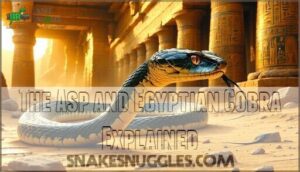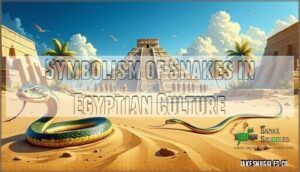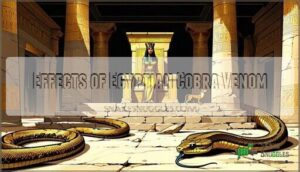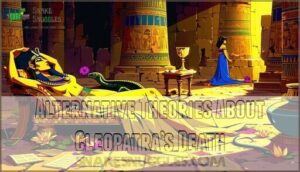This site is supported by our readers. We may earn a commission, at no cost to you, if you purchase through links.
 For your homework on what snake killed Cleopatra, the Egyptian cobra (also called an "asp") is your answer. Plutarch and Strabo, two ancient historians, wrote about how this venomous serpent was smuggled to the queen hidden in a basket of figs.
For your homework on what snake killed Cleopatra, the Egyptian cobra (also called an "asp") is your answer. Plutarch and Strabo, two ancient historians, wrote about how this venomous serpent was smuggled to the queen hidden in a basket of figs.
The cobra wasn’t just a random choice—it symbolized divine power and royal authority in Egyptian culture, making it a fitting end for Egypt’s last pharaoh.
However, modern scholars debate whether Cleopatra actually used the snake or opted for poison instead, since smuggling a five-foot cobra past Roman guards seems pretty tricky. The mystery deepens when you consider the conflicting evidence.
Table Of Contents
- Key Takeaways
- Which Snake Killed Cleopatra?
- How Did Cleopatra Die According to History?
- Examining The Snakebite Theory
- Alternative Theories About Cleopatra’s Death
- The Cultural Legacy of Cleopatra’s Death
- What Do Experts Say Today?
- Frequently Asked Questions (FAQs)
- Was Cleopatra killed by a snake?
- Did a Cobra kill Cleopatra?
- How did Cleopatra die?
- Why did Octavian kill Cleopatra?
- What did Cleopatra do with a snake?
- Who got bitten by an asp?
- What did Cleopatra actually look like?
- Who was the queen of snakes in Egypt?
- How did Cleopatra ensure access to snake venom?
- Were other animals considered for Cleopatras suicide?
- Conclusion
Key Takeaways
- You’ll find that ancient sources point to the Egyptian cobra (called an "asp") as the snake that supposedly killed Cleopatra, though this dramatic story may be more legend than fact.
- You should know that modern scholars seriously question whether a five-foot cobra could have been smuggled past Roman guards into her heavily guarded mausoleum undetected.
- You’re looking at conflicting evidence since German researchers discovered that cobra venom causes painful paralysis rather than the peaceful death described in historical accounts.
- You’ll discover that whether she used a snake or poison, Cleopatra likely chose suicide over facing public humiliation as Octavian’s prisoner in Rome, making her death method less important than her final act of defiance.
Which Snake Killed Cleopatra?
You’ve probably heard that Cleopatra died from an asp bite, but the truth isn’t that simple.
Historical sources point to either an Egyptian cobra or an "asp," though experts debate whether a snake could’ve actually been smuggled into her tomb undetected.
The Asp and Egyptian Cobra Explained
You’ve likely heard about the asp that supposedly killed Cleopatra, but here’s the snake-mystery twist: ancient sources actually describe the Egyptian cobra.
This venomous snake was deeply woven into asp mythology and ancient symbols of Egyptian royalty. The cobra’s deadly snake venom and natural cobra habitat made it both feared and revered, perfectly suited for a queen’s dramatic exit.
Ancient Sources and The Asp Legend
What really happened when Cleopatra died? The truth is messier than most people think. Strabo was there soon after it happened and wrote down two different versions of events. Then Plutarch came along and made the snake story famous – you know, the dramatic asp bite that everyone remembers. Roman poets like Horace loved it too, weaving the serpent tale into their grand narratives about royal power.
These old sources don’t agree on much. Some say it was definitely an Egyptian cobra. Others point to poison. The debate has been going for centuries, and honestly, we’ll probably never know for sure what killed the last pharaoh of Egypt.
Artists have had a field day with this mystery. The Royal Academy tradition especially loved painting Cleopatra’s final moments, usually with that famous snake. These works emphasized classical ideals and drew heavily from those ancient texts we’re still arguing about today.
Symbolism of Snakes in Egyptian Culture
You’ll find snakes weren’t just reptiles in ancient Egypt—they represented divine power itself. Snake symbolism carried deep cultural significance, connecting rulers to gods through royal authority and divine protection.
Ancient Egyptians wove serpents throughout their mythology, with four symbols standing out. The cobra, or uraeus, crowned pharaohs as divine protection. Wadjet serpent represented Lower Egypt’s royal power. Isis took snake form—the goddess Cleopatra claimed to embody. And Apep, the chaos serpent, battled the sun god Ra in eternal conflict.
- Cobra (uraeus) – worn on pharaohs’ crowns as divine protection
- Wadjet serpent – patron goddess of Lower Egypt’s royal authority
- Isis in snake form – goddess Cleopatra believed she embodied
- Apep/Apophis – chaos serpent defeated by sun god Ra
These mythological representations made snakes perfect for a queen’s final act.
How Did Cleopatra Die According to History?
Ancient historians described Cleopatra’s death as a deliberate royal suicide, with Roman sources like Suetonius recounting her fatal encounter with a venomous snake.
The most famous account tells of a serpent hidden in a basket of figs, though you should know that scholars today question whether this dramatic tale matches the historical evidence.
Accounts From Roman and Greek Historians
Through ancient Roman history, you’ll find Plutarch, Suetonius, and Strabo documented Cleopatra’s snake bite death, though historical bias clouds their Greek legends. Roman records from writers like Virgil shaped mythology’s impact on these ancient sources.
Suetonius reported Octavian summoned snake charmers to treat her wounds, yet these accounts reflect political motivations rather than eyewitness testimony.
The Basket of Figs Story
The Fig Basket Story represents the most vivid detail in Cleopatra’s death theories. Ancient sources describe how a deadly snake arrived concealed in a basket of figs, creating the Fruit Basket Legend that’s captivated historians for centuries.
This Ancient Egyptian Myth suggests the snake bite occurred after the queen’s ritual meal, though Royal Death Theories question whether an Egyptian cobra could realistically hide among the fruit without detection.
The historical accounts of Cleopatra’s life and death are influenced by Roman Empire records that have shaped our understanding of her legacy.
Octavian’s Role and Aftermath
When Cleopatra died, Octavian’s motives became crystal clear: Egyptian annexation secured Rome’s grain supply and removed his last rival. The power struggle ended with Roman conquest, transforming Egypt into an imperial province.
Octavian’s role in Cleopatra’s death allowed him to monopolize Caesar’s legacy and establish Roman Empire expansion . After her death, he executed Caesarion, ending the Ptolemaic dynasty.
Examining The Snakebite Theory
Ancient Egypt’s deadly serpents tell an interesting story. The Egyptian cobra and saw-scaled viper both called this region home, making the snakebite theory at least plausible from a biological standpoint.
However, you’ll also find that smuggling a five-foot cobra into Cleopatra’s heavily guarded mausoleum presents some pretty serious logistical challenges that historians can’t ignore.
Types of Venomous Snakes in Ancient Egypt
Ancient Egypt housed a dangerous collection of venomous snakes that could’ve caused Cleopatra’s death. The Echis coloratus, a venomous species belonging to the Viperidae family, and the Egyptian Cobra dominated snake habitats across the Nile.
These vipers and cobras weren’t just Ancient Myths—their Venom Types ranged from deadly neurotoxins to blood-clotting agents. Reptile Symbolism made them perfect for royal executions.
Effects of Egyptian Cobra Venom
Egyptian cobra venom packs a deadly punch that would’ve made Cleopatra’s death swift yet agonizing. The venom composition includes potent neurotoxins that shut down your nervous system. You’d experience rapid muscle paralysis, respiratory failure, and cardiac arrest within hours.
Snake bite symptoms start with local swelling, then progress to breathing difficulties. Cobra venom effects deliver toxicity levels capable of killing an Egyptian queen efficiently through precise venom delivery mechanisms.
Challenges of Smuggling a Snake
When you consider the logistics, smuggling a venomous snake into Cleopatra’s heavily guarded mausoleum presents serious challenges. Detection risks would’ve been enormous given ancient security measures.
- Snake concealment required containers large enough for venomous species
- Smuggling methods faced scrutiny from Roman guards
- Snake behavior becomes unpredictable under stress
- Herpetology shows poisonous snake handling demands expertise
Alternative Theories About Cleopatra’s Death
The snake bite narrative represents just one theory among several that historians actively debate regarding Cleopatra’s final moments.
Modern scholars debate whether she used poison, other toxins, or if the entire narrative was crafted by Roman propaganda to shape her legacy.
Poison or Self-Administered Toxins
You might wonder if Cleopatra skipped the snake bite entirely. Some scholars propose she used a self-administered toxic substance instead.
Poison delivery through drinks or pills would’ve been simpler than smuggling poisonous animals. Toxicology analysis suggests certain plant-based toxins could mimic snake venom effects without requiring actual venom from snakes.
Modern Historians’ Debates
Modern historians don’t agree on what really killed Cleopatra. The old story about a snake bite? Many experts now doubt it happened that way.
Dr. Joyce Tyldesley points out the obvious problem: how do you smuggle a deadly serpent past Roman guards?
Instead of just accepting ancient accounts, today’s scholars dig into the evidence. They’re asking harder questions about what actually makes sense given what we know about palace security, Egyptian burial practices, and the political situation when Cleopatra died.
Evidence Supporting and Refuting Snakebite
You’ll find conflicting evidence in Cleopatra’s death theories. Ancient myths endorse snakebite narratives, emphasizing symbolic significance and venom delivery methods.
However, herpetology reveals snake behavior problems—cobras are too large for secret transport. Historical debates question ancient snakebite fatalities’ practicality.
Physical evidence remains absent, while venom effects don’t match described peaceful death scenarios.
The Cultural Legacy of Cleopatra’s Death
Cleopatra’s death story transcended mere historical record to become something much bigger—a lasting symbol that continues influencing how we think about royal power and dramatic finales.
Whether she actually died from a snake bite or not, the legend has inspired countless works of art, literature, and films, cementing her place as history’s most famous royal suicide.
Whether she actually died from a snake bite or not, the legend has inspired countless works of art, literature, and films, cementing her place as history’s most famous royal suicide.
Cleopatra as a Symbol of Royalty
Beyond these theories lies Cleopatra’s enduring Royal Legacy as the last Queen of Egypt. Her Symbolic Death transformed her into an icon of Egyptian Royalty that outlasted the Ptolemaic kingdom itself. You’ll discover three key aspects of her royal symbolism:
- Divine Authority – She embodied Goddess Isis, claiming divine right to rule
- Ancient Symbols – The asp represented pharaonic power and noble sacrifice
- Eternal Majesty – Her death cemented legendary status across cultures
Artistic and Literary Depictions
Throughout centuries, you’ll discover Cleopatra’s death has captivated artists and writers. Shakespeare’s "Antony and Cleopatra" used poetic license to cement the snake narrative in cultural symbolism.
Historical fiction continues weaving legendary narratives around Cleopatras death theories, with venom becoming shorthand for royal tragedy. These historical accounts transformed fact into enduring myth through artistic interpretation.
Influence on Modern Perceptions
The snake bite story shapes how you perceive Cleopatra today. Public fascination with her dramatic death overshadows historical accounts that question the venom narrative. This cultural impact creates three lasting effects:
- Hollywood glamorizes the asp death in films and TV shows
- Museums display artistic representations featuring snakes and Egyptian symbolism
- Popular culture emphasizes symbolic meaning over ancient herpetology facts
Cleopatra’s death remains more legend than verified historical significance.
What Do Experts Say Today?
Modern scholars take a different approach to Cleopatra’s death, applying scientific methods and rigorous historical analysis to question long-held beliefs.
Researchers like Egyptologist Dr. Joyce Tyldesley and scientists Dietrich Mebs and Christoph Schaefer now challenge the snake bite narrative that’s dominated popular imagination for centuries.
Today’s experts, including Egyptologist Dr. Joyce Tyldesley and researchers like Dietrich Mebs and Christoph Schaefer, question whether the famous snake bite story holds up under scrutiny.
Insights From Dr. Joyce Tyldesley
Dr. Joyce Tyldesley brings decades of expert analysis to Cleopatra’s mysterious death. You’ll find her insights particularly valuable since she’s studied Egyptian culture and ancient symbolism extensively.
She questions the snake theory, noting that royal legacy stories often blend myth with historical context. Tyldesley emphasizes that ancient herpetology knowledge was limited, making venom identification unreliable in contemporary accounts.
Research by Dietrich Mebs and Christoph Schaefer
During pioneering toxicology studies, German researchers Dietrich Mebs and Christoph Schaefer challenged the snake narrative with forensic research. Their venom analysis revealed Egyptian cobra bites cause painful paralysis—not peaceful death.
Their investigation into ancient Egyptian medicine and venomous snakes in antiquity concluded:
- Snake behavior makes smuggling unlikely
- Ancient herpetology and toxicology backs poison theory
- Historical accounts of snakes contradict cobra’s brutal effects
Ongoing Historical and Scientific Investigations
Researchers today go far beyond studying ancient texts to crack Cleopatra’s mystery. They’re bringing cutting-edge science to the table—archaeological discoveries get the full forensic treatment, while specialists in ancient snake biology and toxicology dig into what venomous serpents were actually like back then.
Today’s researchers aren’t just reading Ancient Texts anymore—they’re applying pioneering Scientific Methods to solve Cleopatra’s mystery. Archaeological Finds now undergo Forensic Research, while experts in ancient herpetology and toxicology examine venomous snakes in antiquity.
Modern Historical Analysis combines traditional historical accounts of snakes with pioneering herpetology research and toxicology studies, bringing fresh perspectives to this 2,000-year-old puzzle.
Frequently Asked Questions (FAQs)
Was Cleopatra killed by a snake?
You’ll find conflicting evidence about Cleopatra’s death by snake bite. While ancient sources like Suetonius reported she used a venomous serpent, modern historians question this theory’s validity due to practical concerns.
Did a Cobra kill Cleopatra?
You’ll find the Egyptian cobra theory most compelling among historians. This venomous snake symbolized royalty in ancient Egypt, making it a poetic choice for Cleopatra’s final act.
How did Cleopatra die?
You’ve likely heard the legendary snake story, but historians debate whether it’s fact or fiction.
Most ancient sources suggest Cleopatra died by poison—possibly snake venom from an Egyptian cobra, though some scholars question this dramatic tale’s accuracy.
Why did Octavian kill Cleopatra?
Actually, Octavian didn’t kill Cleopatra – you’ll find she took her own life instead. She chose suicide over facing public humiliation in Rome, where Octavian planned to parade her as a defeated enemy.
What did Cleopatra do with a snake?
Like a final curtain call, you’ll find Cleopatra allegedly used a venomous snake to end her life.
According to legend, she let an Egyptian cobra bite her, choosing death over Roman captivity.
Who got bitten by an asp?
According to legend, you’d find Cleopatra VII, Egypt’s last pharaoh, was the one bitten by an asp. She supposedly used the venomous snake’s bite to end her life in 30 BCE.
What did Cleopatra actually look like?
Picture a puzzle with missing pieces—that’s Cleopatra’s appearance! You’ll see her on ancient coins with a prominent nose, strong chin, and curly hair, but we don’t have reliable evidence of her true physical features.
Who was the queen of snakes in Egypt?
You’re thinking of Wadjet, the cobra goddess who protected Lower Egypt’s pharaohs. She wasn’t technically a queen but rather the serpent deity whose image adorned royal crowns, symbolizing divine authority and protection.
How did Cleopatra ensure access to snake venom?
You’d smuggle a snake in a basket of figs, as ancient accounts suggest. Egyptian cobras were readily available, symbolically perfect for royal suicide, and their venom ensured a dramatic end.
Were other animals considered for Cleopatras suicide?
You’ll find historians debate this point. Ancient sources mention poison as an alternative method Cleopatra considered.
Some scholars suggest she might’ve tested various toxins beforehand, but snakes remained her symbolic choice for their royal Egyptian significance.
Conclusion
Despite centuries of fascination with what snake killed Cleopatra, the truth remains tantalizingly elusive. While ancient historians pointed to the Egyptian cobra as her chosen instrument of death, modern scholars increasingly question this dramatic narrative.
You’re dealing with a puzzle where political propaganda, cultural symbolism, and practical logistics all collide. Whether she used an asp, poison, or another method entirely, Cleopatra’s final act continues enthralling students and researchers alike, proving that history’s greatest mysteries often resist simple answers.
Cleopatra’s death remains history’s ultimate mystery, where legend and politics blur the line between snake bite and suicide
- https://allthatsinteresting.com/how-did-cleopatra-die
- https://archaeologymysteries.com/2023/03/23/how-did-cleopatra-die/
- https://study.com/academy/lesson/egyptian-cobra-overview-myths-facts.html
- https://a-z-animals.com/animals/asp/
- https://www.natgeokids.com/nz/discover/history/egypt/cleopatra-snake-scientists-impossible/
















